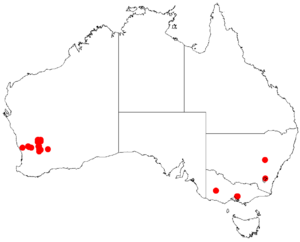Sandpaper wattle facts for kids
Quick facts for kids Sandpaper wattle |
|
|---|---|
 |
|
| Conservation status | |
| Scientific classification | |
| Genus: |
Acacia
|
| Species: |
denticulosa
|
 |
|
| Occurrence data from AVH | |
| Synonyms | |
|
Racosperma denticulosum (F.Muell.) Pedley |
|
The Acacia denticulosa, also known as sandpaper wattle, is a type of plant found in Western Australia. It's a tall, thin shrub that usually grows between 1 and 4 meters (about 3 to 13 feet) high. This wattle gets its name "sandpaper" because its leaves and young stems feel rough to the touch. It blooms with bright yellow flowers from September to October, which grow in dense, curved spikes.
Contents
What's in a Name?
The sandpaper wattle was officially named in 1876 by a botanist named Ferdinand von Mueller. He studied plants collected by Jess Young near Mount Churchman. Sadly, the plants at that specific spot are no longer found there because of a very long dry period. The name denticulosa comes from a Latin word meaning "tooth," which refers to the small, tooth-like edges on its leaf-like parts. For a short time, some scientists called it Racosperma denticulosum, but it's now known by its original name.
What Does it Look Like?
The sandpaper wattle is a thin shrub that can grow from 1 to 4 meters (about 3 to 13 feet) tall and up to 3 meters (about 10 feet) wide. Its young stems and dark green leaf-like parts, called phyllodes, feel rough and bumpy.
Like many wattles, what look like leaves are actually flattened stems called phyllodes. These phyllodes are shaped like irregular ovals, about 5 to 9 centimeters (2 to 3.5 inches) long and 3.5 to 7.5 centimeters (1.4 to 3 inches) wide. They have clear veins running through them.
The plant blooms in September and October, showing off bright golden flower spikes. These spikes are shaped like cylinders and are 3 to 8 centimeters (1.2 to 3.1 inches) long. After the flowers, the plant grows seedpods that are straight or slightly curved. They can be up to 7.5 centimeters (3 inches) long and have bumps where the seeds are. The seeds themselves are shiny brownish-black and about 0.35 to 0.4 centimeters (0.14 to 0.16 inches) long.
Where Does it Grow?
The sandpaper wattle is found in eight different areas in the Merredin region of Western Australia. This area is northeast of Perth and stretches about 180 kilometers (112 miles). You can usually find it growing on or near large granite rocks. Sometimes, it also grows on sandy plains or in different types of soil like silt, clay, loam, or sand.
This plant is listed as vulnerable by both Western Australian and Australian laws. This means it needs protection because its numbers are decreasing. Some of the main reasons it's in danger include land being cleared for other uses, changes in water flow, and long periods of drought. Also, some invasive weeds like bridal creeper (Asparagus asparagoides), saffron thistle (Carthamus lanatus), and cape tulip (Moraea flaccida) can harm it.
Growing Sandpaper Wattle
The sandpaper wattle is a great plant for gardens because of its unique leaf-like parts and bright flowers. It also attracts birds. All wattles are legumes, which means they help add important nutrients like nitrogen to the soil.
It's easy to grow sandpaper wattle from seeds, and it grows quickly. It can even flower in its first year! In a garden, its flowering season can last until early summer. This plant needs a sunny spot and soil that drains well. However, it might not do well in places that have very humid summers.
Images for kids




